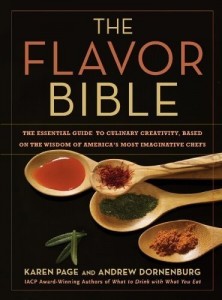Editor’s note: this post is the third, concluding part of a series. The first part reviewed a beginner’s book, New Best Recipe. For an intermediate book, see the review of Ratio.
Ten years after I started to cook, I’m a good cook. I can make the scrambled eggs that troubled me 10 years prior. I make meals without a recipe more often than I use one. When I use a recipe, I’ll liberally make changes and they work. I make 5 course dinners for special occasions, have served dessert for 100, and have cooked on national television. I still use the New Best Recipe and Ratio regularly, but that’s not always what I’m looking for. More often than not, I need inspiration rather than directions.
The Flavor Bible is my favorite book these days. The premise is simple: it’s a thesaurus of flavors. Look up any ingredient and the book lists complimentary flavors, using font to indicate strength of pairing. It is not a recipe book. There are no rules or structure. It’s a reference book more than anything else. There are essays on flavor, pairing, and balance; the book is chock full of beautiful photography; and the world’s greatest chefs (favoring Americans) contribute their favorite flavor pairings for certain ingredients; but that’s all secondary to the lists.
The previous two books (New Best Recipe and Ratio) really taught me the how of cooking. The Flavor Bible wasn’t nearly as informative in my learning process, but it’s my most frequently referenced these days. This is the book I come to for inspiration, when I have an ingredient I know I want to use but don’t know what to do with, when I want to wow someone (myself included), when I want something tried and true, or when I want something off the wall. The book might remind me of a common flavor pairing or suggest something wild, but it always leads me in the right direction. Some examples:
Smoked Salmon
- You probably already know: capers chives, cream cheese, dill, bagels, and red onions
- But avoid mayonnaise?
- What about adding Pernod, juniper, or avocados?
Cauliflower
- Sweet: chocolate with caramelized cauliflower
- For antipasti-like taste: anchovies, red pepper flake, garlic, and olive oil
- Fruity: curry and apple
- Or exotic: cream and sorrel
Gin
- Tonic is overused. Try basil & lemon zest instead.
- Another herbal combination: cilantro + lime
In addition to individual ingredients, the book also covers larger categories, listing things that may go well with cheese, say. More interestingly though are the categories for whole cuisines (Mexican, Thai, Indian, etc.) which allow you to quickly approximate a flavor profile. For instance: Flavors of Thai cuisine include lemongrass, cilantro, coconut milk, chile peppers, and fish sauce.
Before I found this book, I was comfortable making my dinner from scratch without a recipe to guide every step of the way, but I found myself doing the same things over and over. When I had something truly exquisite at a restaurant or watched some piece of magic on a cooking show, I found I often understood the technique but marveled at the inspiration, the combination of flavors. This is the book that has really helped me take that step in my cooking, to be really inventive, novel, and interesting in my kitchen.
So there you go. Three books that have been integral to my growth as a cook, have served me well over ten years, that I recommend every chance I get, and that I use every day. Pick whichever one suits your needs, but you can’t go wrong with any of them.
Filed under reviews
Tagged: three books for every kitchen


I love this book, when you combine it with the rule of thumb that if A goes with B and C goes with D then A and D will work together you can really come up with some fantastic combinations.
I’ve made a mess of that rule, I meant this: if A goes with B and B goes with C then something that goes with C will also work with A.